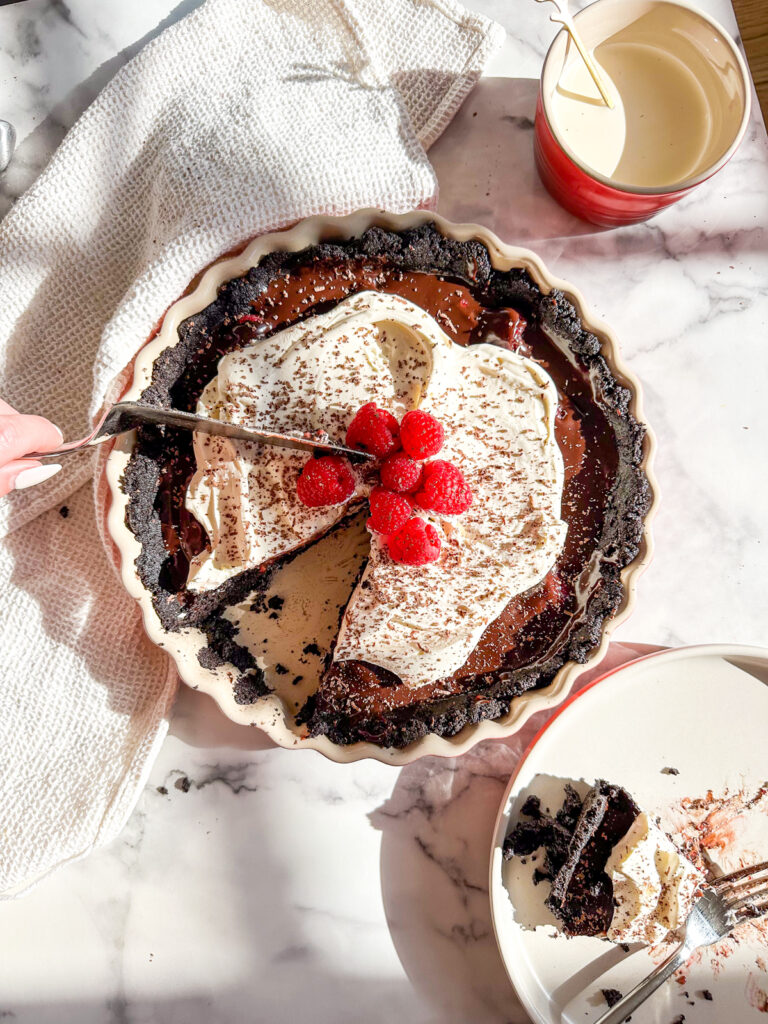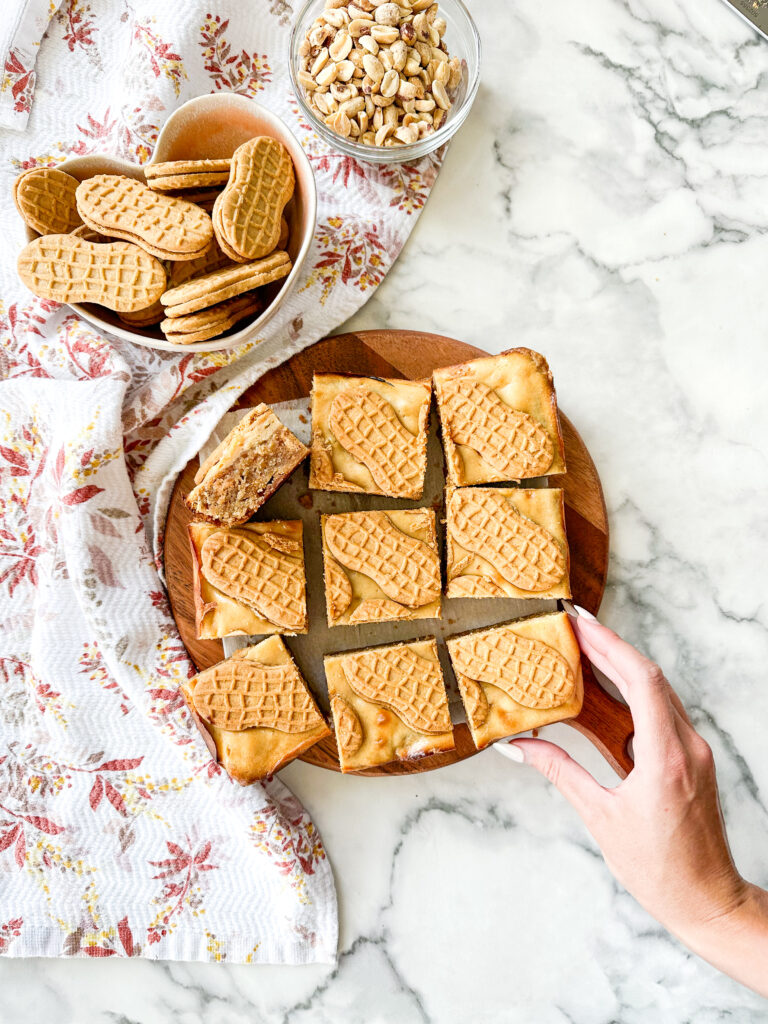These Gingerbread Christmas Trees are such a cute way to serve up gingerbread for guests, or make a great bake to make with the family! They don’t require the engineering or slow hands that a gingerbread house requires, and feels altogether far less stressful! Simply make the gingerbread, cut the stars out then bake. After baking, pipe icing around the edges of the stars and layer up, alternating where the points sit!
There is some chill time required to really firm up the gingerbread. This is necessary otherwise you’ll find the shapes lose their form and you end up with blob shaped cookies! That said, it’s easy to make the dough in advance then you can come back, shape and bake when ready! This leaves plenty of time in between to get other things done! The hands on time is relatively low, but is a great way to spend a cozy festive day in. Pour some eggnog or mulled wine and you’re in for a really fun day of making delicious things.
Gingerbread, a treat beloved around the world, evokes images of festive holidays, cozy kitchens, and intricate baked creations. But beyond its delicious taste and holiday association, gingerbread boasts a rich history and versatile uses. Whether enjoyed in the form of cookies, houses, or cakes, gingerbread holds a special place in global culinary traditions. In this article, we’ll explore the origins of gingerbread, its evolution over time, and why it continues to be a cherished part of modern life.

The Origins of Gingerbread: From Ancient Spices to Sweet Delights
The history of gingerbread dates back over a thousand years. The word “gingerbread” is derived from the Old French word “gingembre,” which refers to ginger, a key ingredient in the recipe. Ancient civilizations, including the Egyptians, used ginger in medicinal concoctions, but it wasn’t until the Middle Ages that gingerbread began to take the form we recognize today.
Gingerbread in Ancient and Medieval Times
The earliest recorded use of gingerbread comes from ancient Greece, where it was made as a sweet bread. However, it wasn’t until the 10th century that gingerbread began to take on its modern shape and flavor. In Europe, particularly in the regions of Greece, Turkey, and Persia, people began combining ground ginger with honey and breadcrumbs, creating early forms of the confection. These early versions were far less sweet than what we enjoy today but still showcased the unique combination of spices that would later define gingerbread.
In medieval Europe, gingerbread evolved into a more recognizable form, typically made with breadcrumbs, honey, and a blend of spices like cinnamon, cloves, and, of course, ginger. These were not the sweet, crispy cookies we associate with gingerbread today, but rather, soft loaves that were often served during feasts and festivals.
The Rise of Gingerbread in Europe
By the 15th century, gingerbread had firmly established itself as a popular treat throughout Europe. It was made by professional bakers who specialized in this craft, and it began to gain popularity at fairs, festivals, and marketplaces. In England, for example, gingerbread was molded into shapes like animals, religious symbols, and even figures of saints, making it both an edible and decorative item.
The Gingerbread Cookie and House Tradition
The tradition of gingerbread cookies and gingerbread houses is traced back to Germany. The famous gingerbread houses, a hallmark of the Christmas season, became popular after the publication of the fairy tale Hansel and Gretel by the Brothers Grimm in the 19th century. The story, which involves a house made entirely of candy, helped cement the connection between gingerbread and the holiday season.
It was in Germany where gingerbread cookies, often decorated with icing and shaped into whimsical figures, became a staple of Christmas traditions. These cookies, known as Lebkuchen in Germany, were baked for Christmas markets and holiday celebrations. Over time, this practice spread to other countries, with each region adding its own twists and variations.
The Secret Ingredients: What Makes Gingerbread So Special?
The key to gingerbread’s distinctive flavor lies in its combination of spices, most notably ginger. The spicy, slightly peppery flavor of ginger is complemented by the sweetness of molasses, honey, or sugar. A blend of other warm spices such as cinnamon, cloves, nutmeg, and allspice gives gingerbread its depth and complexity.
- Ginger: The star of the show, ginger, not only imparts its unique spicy flavor but also has health benefits. It has long been used to aid digestion and soothe nausea, making gingerbread both delicious and potentially soothing.
- Molasses or Honey: Both molasses and honey are key to giving gingerbread its moist texture and rich sweetness. Molasses, in particular, adds a deep, slightly bitter flavor that balances the spiciness of the ginger.
- Cinnamon and Cloves: These warm spices complement the ginger and add their own depth of flavor. Cinnamon offers a sweet, woody aroma, while cloves bring a slightly smoky, intense flavor.
The combination of these ingredients makes gingerbread a truly comforting and satisfying treat.
Gingerbread Around the World: A Global Tradition
Though gingerbread is most commonly associated with Western holidays, it has versions across the globe. Here is how gingerbread is enjoyed in different cultures:
Germany: Lebkuchen
In Germany, gingerbread is known as Lebkuchen, and it is sold at Christmas markets. This version is typically softer than its British or American counterpart and may include nuts, candied fruit, or a dusting of powdered sugar. In some regions of Germany, gingerbread is made into heart-shaped cookies and decorated with colorful icing, a custom that can be traced back to medieval times.
United Kingdom: Gingerbread Biscuits
In the UK, gingerbread is usually enjoyed in the form of biscuits (cookies). Traditional recipes include ginger, treacle, and sometimes golden syrup, resulting in a slightly crisp, yet tender cookie. Gingerbread men and women are especially popular around Christmas time, and these cookies are decorated with icing or candy.
Sweden: Pepparkakor
In Sweden, Pepparkakor are thin, crispy gingerbread cookies that are enjoyed during the Christmas season. These cookies are typically cut into shapes like stars, hearts, or animals and are enjoyed with a warm drink of glögg (a Swedish mulled wine). Swedes have a long-standing tradition of baking Pepparkakor together as a family activity during the holiday season.
United States: Gingerbread Cookies and Houses
In the United States, gingerbread is a holiday staple, particularly around Christmas. Gingerbread cookies are often shaped into people, animals, or festive symbols like Christmas trees and stars. The tradition of gingerbread houses became popular in the 19th century, and today, families across the country create elaborate, candy-covered gingerbread houses as part of their Christmas celebrations.
Why Gingerbread Endures: The Modern Appeal
Gingerbread’s enduring popularity can be attributed to several factors. Its rich history and cultural significance make it a symbol of tradition and nostalgia. For many, the act of baking gingerbread cookies or assembling gingerbread houses is a cherished family tradition passed down through generations.
Additionally, the comforting aroma of gingerbread baking in the oven evokes feelings of warmth and togetherness, making it an ideal treat for the holiday season. The versatility of gingerbread also contributes to its popularity. It can be enjoyed in so many forms—cookies, cakes, houses, and even as an ingredient in other desserts like gingerbread lattes or ice cream.
Moreover, gingerbread’s health benefits, such as its digestive properties, give it an added appeal in today’s wellness-conscious society. Ginger is known for its anti-inflammatory and antioxidant properties, making gingerbread not only a tasty indulgence but also a treat with potential health benefits.

Tips for Making Great Gingerbread Christmas Trees
- Use Fresh Spices: For the best flavor, make sure your ginger, cinnamon, cloves, and other spices are fresh.
- Choose the Right Molasses: Use unsulfured molasses for a rich, deep flavor. Blackstrap molasses can be too bitter for gingerbread.
- Don’t Overwork the Dough: When mixing your gingerbread dough, avoid overworking it. Over-mixing can lead to tough cookies. Mix until just combined for the best texture.
- Chill the Dough: After preparing your gingerbread dough, chill it for at least 1 hour before rolling it out. This helps prevent spreading and results in firmer cookies.
- Roll to the Right Thickness: Roll the dough to about 1/8 to 1/4 inch thick. Too thin, and your gingerbread may burn or be too crisp; too thick, and it may not bake properly.
- Use Parchment Paper: Line your baking sheets with parchment paper for easy cookie removal and even baking.
- Bake at the Right Temperature: Preheat your oven and bake your gingerbread cookies at 350°F (175°C) for 8–10 minutes. Keep an eye on them to avoid over-baking.
- Shape with Care: Ensure all the shapes are the same size and thickness for even baking.
- Let Cool Completely: Before decorating or assembling, let your gingerbread cool completely to avoid melted icing or collapsing structures.
- Store Properly: Store cookies in an airtight container at room temperature.
- Precision: When decorating intricate designs or attaching pieces of gingerbread for a house, use a piping bag with a small nozzle to control the flow of icing. You can also use a sandwich bag with a corner snipped off – just make sure the corner you snip is really small!
How to Construct the Gingerbread Christmas Trees
To construct the trees, it really is so much more simple than it looks! Once the gingerbread has been refrigerated in sheets remove and cut out stars using a star shaped cookie cutter. Use multiple sizes so that the trees can be stacked, starting with the larger cookies and working up to the smallest. You can easily find a pack of multiple size star cookie cutters online or in larger grocery stores.
Once cut and baked, let cool. Pipe the icing around the edges of the cookies and then place a small dollop of icing in the center of each cookie to ‘glue’ the next one down. Be careful when layering so as not to ruin the icing. The best method is to ice a few, stack them, then repeat to create the trees. If the icing is too set, they won’t stick to one another very well.
Finally, cover with a dusting of powdered sugar. You can absolutely add green food color to the icing to make them look more ‘tree’ like. Alternatively you could add multiple colors in small batches to add baubles/ornaments to really go wild! Optional: add small decorations like sprinkles or shiny sugar balls!
Storage and Make Ahead for Gingerbread Christmas Trees
When it comes to storing fresh cookies, it’s essential to maintain their texture and flavor. Here are a few tips to help you store your cookies effectively:
- Pantry/Cupboards: As these cookies don’t contain perishable frostings or ingredients, they should be stored in the pantry or cupboard or any cool, dry place. Place in an airtight container or zip-loc bags. They will last about 3 days, although you may find they start to go a little soft on the third day.
- Freezing: Cookies can generally be frozen for up to 3 months. To freeze, arrange them in a single layer on a baking sheet and place in the freezer. Once frozen, transfer them to an airtight container or freezer bag with layers separated by parchment paper. Thaw them at room temperature before serving.
I bake these Gingerbread Christmas Trees using large cookie sheets. For more cookie ideas, check out these Peanut Butter Cookies. For videos and baking inspiration, head on over to my Instagram. If you make this recipe, don’t forget to drop it a star rating, leave a review or share a photo on your socials!


Gingerbread Christmas Trees
Ingredients
- 440 g (3 ½ cups) All Purpose Flour Plain Flour
- 1 tbsp (1 tbsp) Ground Ginger
- 1 tbsp (1 tbsp) Ground Cinnamon
- 1 tsp (1 tsp) Ground Cloves
- 1 tsp (1 tsp) Baking Powder
- 140 g (10 tbsp) Unsalted Butter Room Temperature
- 150 g (⅔ cups) Light Brown Soft Sugar
- 200 g (½ cups) Molasses or Treacle
- 1 (1) Large Egg
For the Icing
- 2 tbsp (2 tbsp) Unsalted Butter
- 260 g (2 cups) Powdered Sugar Icing Sugar
- 2 tbsp (2 tbsp) Milk
- Powdered Sugar to decorate
Instructions
- In a large bowl using an electric mixer, or stand mixer, combine beat the butter until light and creamy. Add in the brown sugar and molasses (or treacle) until fully combined. Then add the egg and beat again.
- Add the flour, baking powder, cinnamon, ginger and cloves and beat on low until fully combined. Roll the dough into two balls, wrap with cling film or seran wrap and place in the fridge for 3+ hours (or overnight if making ahead).
- Preheat the oven to 350℉/180℃. Line 2 large baking trays.
- Working with one ball of dough at a time, flour your surface and roll to 1/4 inch thickness. Use different sized star cookie cutters to cut out an equal amount of large/medium/small stars.
- Place on the lined baking trays, leaving a little room for spreading and bake for 10 minutes. Remove and let cool. Repeat for all dough.
For the Icing/Assembly
- Once the dough has fully cooled, make the icing by whisking together all ingredients. Place into a piping bag with a very small nozzle, or in a sandwich bag and snip a tiny corner off.
- Working with one 'tree' at a time, pipe around the edges of each star and place a small dollop of icing in the middle of each (apart from the smallest stars). Starting with the largest cookie as the base, stack upwards, getting smaller and alternating where the points sit.
- Dust with powdered sugar to finish! Keep in an airtight container in a cool dry place to store.














